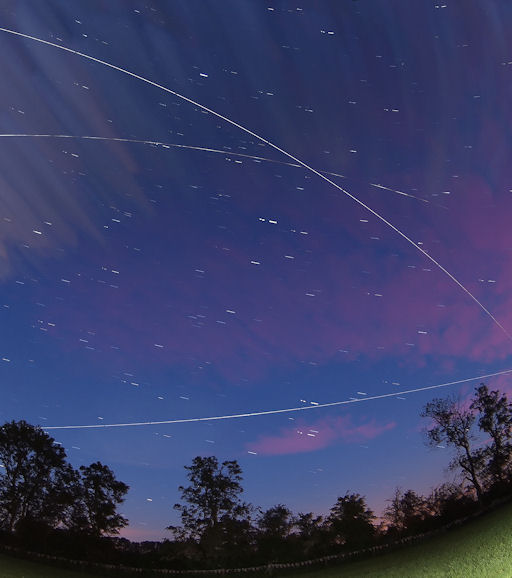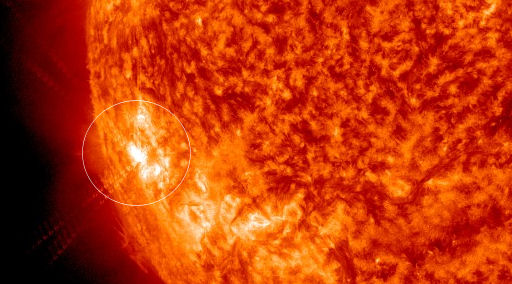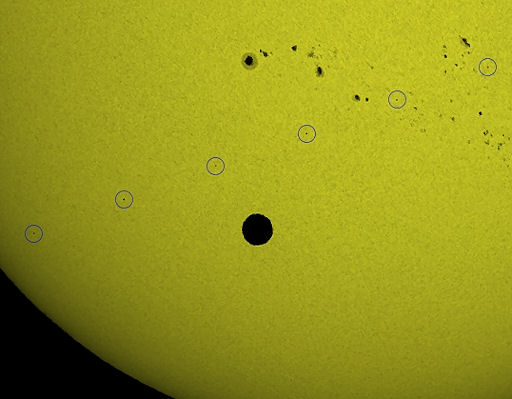Listen to radar echoes from satellites and meteors, live on listener-supported Space Weather Radio. | | |
CHANCE OF MAGNETIC STORMS: NOAA forecasters estimate a 30% chance of polar geomagnetic storms during the next 48 hours as a pair of CMEs pass by Earth, possibly delivering glancing blows to our magnetic field. Magnetic storm alerts: text, voice.
TRIPLE FLYBY: As the solstice approaches on June 20th, the International Space Station is spending some extra time in the sun. Ironically, this means you're more likely to see it in the night sky. Mark Humpage photographed three ISS flybys over his home in Lutterworth UK on June 10th:

"There were actually four flybys this evening at 2207, 2343, 0119 and 0256 hrs, however, the first was clouded out," says Humpage. "I added a few bursts of flash just before the first flyby to light up the garden and then left the camera running all night. The following morning I extracted all the images and stacked them to produce the final composite."
Readers, now is a great time to look for the behemoth spacecraft glistening in sunlight among the stars. Flyby times are available on your smartphone or from Space Weather's Simple Satellite Tracker.
M-FLARES: New sunspot AR1504 is crackling with impulsive M-class solar flares. NASA's Solar Dynamics Observatory photographed the extreme UV flash from one of them, an M2-class flare on June 10th at 0645 UT:

So far none of the blasts have been Earth directed, but geoeffective eruptions are possible in the days ahead as AR1504 turns toward Earth. NOAA forecasters estimate a 45% chance of more M-flares today. Stay tuned.Solar flare alerts: text, voice.
HUBBLE TRANSIT OF VENUS: One of the big ironies of the 2012 Transit of Venus was that NASA's greatest telescope didn't dare photograph the event. Hubble's instruments are so sensitive, one look at the glaring sun would have crippled its instruments. Nevertheless, Hubble managed to join the show. Astrophotographer Theirry Legault caught the observatory flitting in front of the sun alongside Venus:

"I was in north-east Australia for the full transit of Venus and a transit of Hubble in the middle," says Legault. "My Nikon D4 digital camera was working at 10 fps on a Takahashi FSQ-106ED telescope to record 9 images of HST during its 0.9s transit."
This is certainly an historic photo. Imagine what James Cook would think of a telescope in space crossing his field of view as he watched the transit of 1769 from a beach in Tahiti. Moreover, imagine what kind of telescopes will be crossing the sun when the next Transit of Venus occurs in 2117. Congratulations to Legault for capturing a truly rare 0.9s slice of history.
More slices of history may be found in the Transit of Venus Photo Gallery:
Realtime Transit of Venus Photo Gallery
[Submit your photos] [NASA videos: 2012 Transit of Venus, ISS Transit of Venus]
Potentially Hazardous Asteroids (
PHAs) are space rocks larger than approximately 100m that can come closer to Earth than 0.05 AU. None of the known PHAs is on a collision course with our planet, although astronomers are finding
new ones all the time.
On June 10, 2012 there were 1311 potentially hazardous asteroids.
Notes: LD means "Lunar Distance." 1 LD = 384,401 km, the distance between Earth and the Moon. 1 LD also equals 0.00256 AU. MAG is the visual magnitude of the asteroid on the date of closest approach. | | The official U.S. government space weather bureau |
| | The first place to look for information about sundogs, pillars, rainbows and related phenomena. |
| | Researchers call it a "Hubble for the sun." SDO is the most advanced solar observatory ever. |
| | 3D views of the sun from NASA's Solar and Terrestrial Relations Observatory |
| | Realtime and archival images of the Sun from SOHO. |
| | from the NOAA Space Environment Center |
| | the underlying science of space weather |

